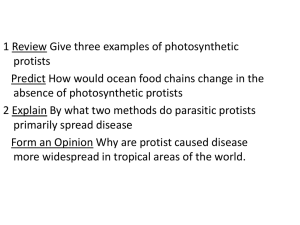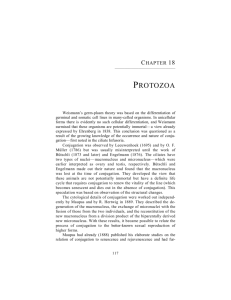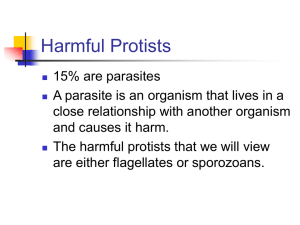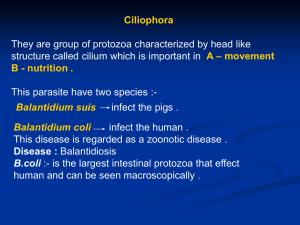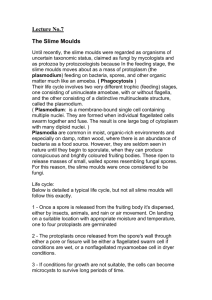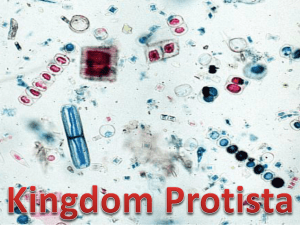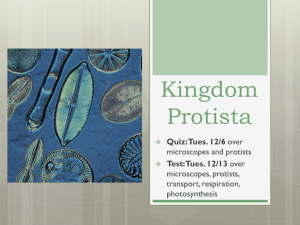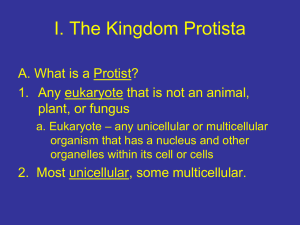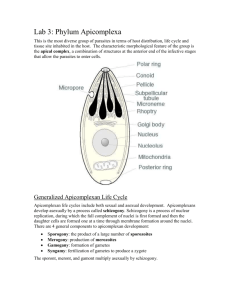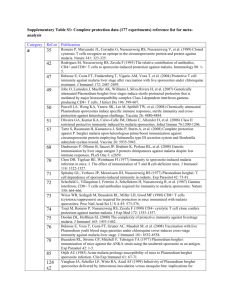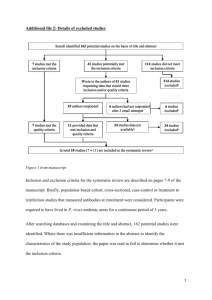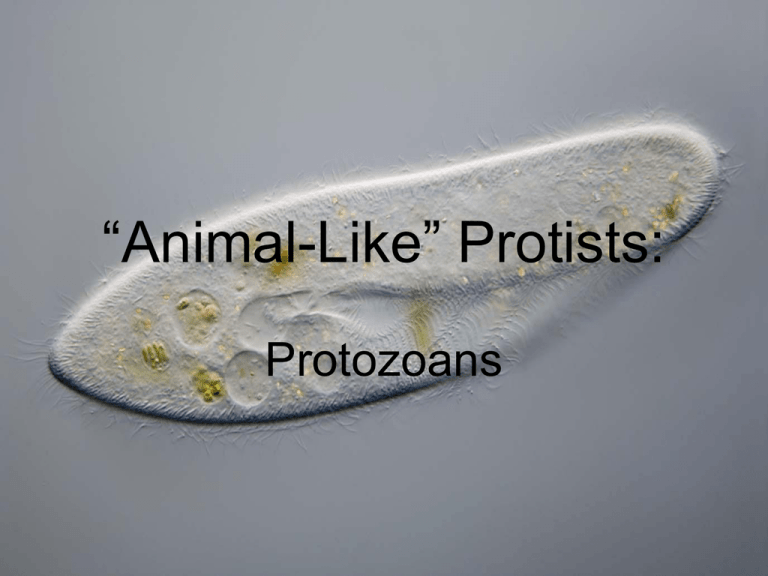
“Animal-Like” Protists:
Protozoans
“Animal-like” Protists: Protozoans
• Kingdom Protista
• Four phyla of “animal-like” protists
differentiated by locomotion
• All heterotrophs
Phylum Zoomastigina - Flagellates
• Move by flagella – long, whip-like
structures
• Absorb food through cell
membranes
• No shell
• Some free-living, some parasites
• Most reproduce asexually by
binary fission = genetically
identical. Some reproduce
sexually as well – gametes
formed by meiosis = new
combination of genetic
information.
Phylum Sarcodina - Sarcodines
• Best known sarcodina is
amoeba
• Move and feed by use of
pseudopods – temporary
projections of cytoplasm
• No body shape, the “blob”
• Move by amoeboid movement
– cytoplasm of the cell
streams into the pseudopod,
and the rest of the cell follows
• Food vacuole temporarily
stores food
• Reproduce by binary fission
Amoeboid Movement
Amoeba Anatomy
Contractile vacuole
Pseudopods
Nucleus
Food vacuole
Other Sarcodinas
• Heliozoans and radiolarians – these both produce shells of SiO2
(silica)
• Foraminifers – produce shells of CaCO3 (calcium carbonate), used
in dating rocks and chalk
Phylum Ciliophora – Ciliates
• Cilia – short, hair-like
projections used in
feeding and/or
locomotion
• Found in fresh and
saltwater
• Most are free-living
• Genus Paramecium
one of the most
studied protists
Anatomy of Typical ciliate
• Pellicle – “skin”
• Trichocysts – small, bottle-shaped structures used for
defense and protection
• Macronucleus – daily genetic material
• Micronucleus – contains “reserve copy” of cell’s
genes/reproduction genetic material
• Gullet – indentation in one side of organism to trap food
• Food vacuole – food storage and digestion
• Anal pore – excretion
• Contractile vacuoles – collect water and when full,
contracts, pumping water out
– Why is this necessary?
Paramecium Anatomy
Trichocysts
Lysosomes
Oral groove
Gullet
Anal pore
Contractile vacuole
Micronucleus
Macronucleus
Food vacuoles
Cilia
Reproduction of Ciliates
• Under most conditions, ciliates reproduce
asexually by mitosis and binary fission – cell
splits lengthwise, forming 2 genetically identical
cells
• When placed under stress, conjugation may
occur
• Conjugation allows for a crossover of genetic
information, but in the end, the two cells are
genetically the same – the two cells simply
swapped half of each other’s genetic
information. This does make new combinations
of genes though = genetic diversity
Conjugation
Macronucleus
Micronucleus
Conjugation
Macronucleus
Micronucleus
Conjugation
Macronucleus
Micronucleus
Conjugation
Macronucleus
Micronucleus
Phylum Sporozoa - Sporozoans
Plasmodium killing red blood
cells
• Do not move, all are
parasitic
• Live in worms, insects,
fish, birds, and humans
• Very complex life cycles
• Reproduce by means of
spores (groups of cells
which invade a new
host)
The Life Cycle of Plasmodium
Plasmodium undergoes several
stages of development in
mosquito’s body
Mosquito bites human,
injecting saliva that contains
Plasmodium sporozoites
Plasmodium sporozoites
Anopheles mosquito bites
infected human and picks up
Plasmodium cells
Infected red blood cells
burst, releasing Plasmodium
cells; some can infect other
red blood cells, and others
can infect mosquitoes
Sporozoites infect
liver cells
Liver
Infected liver cells burst,
releasing Plasmodium cells
that infect red blood cells
Plasmodium cells
Red blood cells
“Animal-like” Protists and Disease
• Sporozoans –
Plasmodium –
malaria
• Zoomastigina –
Trypanosoma –
African sleeping
sickness
• Sarcodina –
Entamoeba – amebic
dysentery
Ecology of “Animal-like” Protists –
Helpful
• Serve as food at the
base of the food chain
• Trichonympha – live
inside termites and
help break down
cellulose in wood for
termites to then digest


